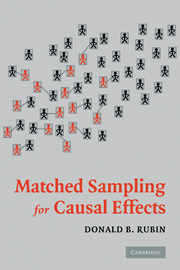Book contents
- Frontmatter
- Contents
- Contributor Acknowledgments
- Matched Sampling for Causal Effects
- My Introduction to Matched Sampling
- PART I THE EARLY YEARS AND THE INFLUENCE OF WILLIAM G. COCHRAN
- PART II UNIVARIATE MATCHING METHODS AND THE DANGERS OF REGRESSION ADJUSTMENT
- PART III BASIC THEORY OF MULTIVARIATE MATCHING
- PART IV FUNDAMENTALS OF PROPENSITY SCORE MATCHING
- 10 The Central Role of the Propensity Score in Observational Studies for Causal Effects
- 11 Assessing Sensitivity to an Unobserved Binary Covariate in an Observational Study with Binary Outcome
- 12 Reducing Bias in Observational Studies Using Subclassification on the Propensity Score
- 13 Constructing a Control Group Using Multivariate Matched Sampling Methods That Incorporate the Propensity Score
- 14 The Bias Due to Incomplete Matching
- PART V AFFINELY INVARIANT MATCHING METHODS WITH ELLIPSOIDALLY SYMMETRIC DISTRIBUTIONS, THEORY AND METHODOLOGY
- PART VI SOME APPLIED CONTRIBUTIONS
- PART VII SOME FOCUSED APPLICATIONS
- Conclusion: Advice to the Investigator
- References
- Author Index
- Subject Index
10 - The Central Role of the Propensity Score in Observational Studies for Causal Effects
Published online by Cambridge University Press: 05 June 2012
- Frontmatter
- Contents
- Contributor Acknowledgments
- Matched Sampling for Causal Effects
- My Introduction to Matched Sampling
- PART I THE EARLY YEARS AND THE INFLUENCE OF WILLIAM G. COCHRAN
- PART II UNIVARIATE MATCHING METHODS AND THE DANGERS OF REGRESSION ADJUSTMENT
- PART III BASIC THEORY OF MULTIVARIATE MATCHING
- PART IV FUNDAMENTALS OF PROPENSITY SCORE MATCHING
- 10 The Central Role of the Propensity Score in Observational Studies for Causal Effects
- 11 Assessing Sensitivity to an Unobserved Binary Covariate in an Observational Study with Binary Outcome
- 12 Reducing Bias in Observational Studies Using Subclassification on the Propensity Score
- 13 Constructing a Control Group Using Multivariate Matched Sampling Methods That Incorporate the Propensity Score
- 14 The Bias Due to Incomplete Matching
- PART V AFFINELY INVARIANT MATCHING METHODS WITH ELLIPSOIDALLY SYMMETRIC DISTRIBUTIONS, THEORY AND METHODOLOGY
- PART VI SOME APPLIED CONTRIBUTIONS
- PART VII SOME FOCUSED APPLICATIONS
- Conclusion: Advice to the Investigator
- References
- Author Index
- Subject Index
Summary
Abstract: The propensity score is the conditional probability of assignment to a particular treatment given a vector of observed covariates. Both large and small sample theory show that adjustment for the scalar propensity score is sufficient to remove bias due to all observed covariates. Applications include: (i) matched sampling on the univariate propensity score, which is a generalization of discriminant matching, (ii) multivariate adjustment by subclassification on the propensity score where the same subclasses are used to estimate treatment effects for all outcome variables and in all subpopulations, and (iii) visual representation of multivariate covariance adjustment by a two-dimensional plot.
DEFINITIONS
The Structure of Studies for Causal Effects
Inferences about the effects of treatments involve speculations about the effect one treatment would have had on a unit which, in fact, received some other treatment. We consider the case of two treatments, numbered 1 and 0. In principle, the ith of the N units under study has both a response r1i that would have resulted if it had received treatment 1, and a response r0i that would have resulted if it had received treatment 0. In this formulation, causal effects are comparisons of r1i and r0i, for example r1i – r0i or r1i/r0i. Since each unit receives only one treatment, either r1i or r0i is observed, but not both, so comparisons of r1i and r0i imply some degree of speculation.
Information
- Type
- Chapter
- Information
- Matched Sampling for Causal Effects , pp. 170 - 184Publisher: Cambridge University PressPrint publication year: 2006
Accessibility standard: Unknown
Why this information is here
This section outlines the accessibility features of this content - including support for screen readers, full keyboard navigation and high-contrast display options. This may not be relevant for you.Accessibility Information
- 71
- Cited by
